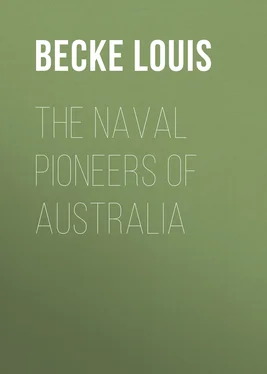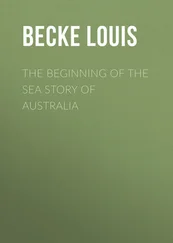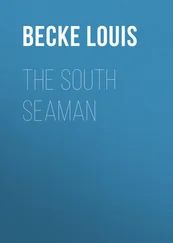Louis Becke - The Naval Pioneers of Australia
Здесь есть возможность читать онлайн «Louis Becke - The Naval Pioneers of Australia» — ознакомительный отрывок электронной книги совершенно бесплатно, а после прочтения отрывка купить полную версию. В некоторых случаях можно слушать аудио, скачать через торрент в формате fb2 и присутствует краткое содержание. Жанр: foreign_prose, literature_19, foreign_antique, на английском языке. Описание произведения, (предисловие) а так же отзывы посетителей доступны на портале библиотеки ЛибКат.
- Название:The Naval Pioneers of Australia
- Автор:
- Жанр:
- Год:неизвестен
- ISBN:нет данных
- Рейтинг книги:4 / 5. Голосов: 1
-
Избранное:Добавить в избранное
- Отзывы:
-
Ваша оценка:
- 80
- 1
- 2
- 3
- 4
- 5
The Naval Pioneers of Australia: краткое содержание, описание и аннотация
Предлагаем к чтению аннотацию, описание, краткое содержание или предисловие (зависит от того, что написал сам автор книги «The Naval Pioneers of Australia»). Если вы не нашли необходимую информацию о книге — напишите в комментариях, мы постараемся отыскать её.
The Naval Pioneers of Australia — читать онлайн ознакомительный отрывок
Ниже представлен текст книги, разбитый по страницам. Система сохранения места последней прочитанной страницы, позволяет с удобством читать онлайн бесплатно книгу «The Naval Pioneers of Australia», без необходимости каждый раз заново искать на чём Вы остановились. Поставьте закладку, и сможете в любой момент перейти на страницу, на которой закончили чтение.
Интервал:
Закладка:
"The spritsail topsail being wore to rags, it was condemned as unfit for its proper use, and taken to repair the topgall'ntsails, they being so bad as not to be worth the expense of new canvas, but, with the help of this sail, will be made to last some time; also took out one of the ship's tents (50) yards of canvas to repair the jibb that was split on the 1st instant, there being neither new canvas nor twine in the ship to spare for that purpose."
But the most serious trouble was when on the 11th of June the Endeavour got ashore on the Barrier Reef. Here is Cook's entry:—
"Shoal'd the water from 20 to 17 faths., and before the man in the chains could have another cast the ship struck and lay fast on some rocks, upon which we took in all sail, hoisted out the boats, and sounded round the ship, and found that we had got upon the edge of a reef of coral rocks, which lay to the N.W. of us, having in some places round the ship 3 or 4 fathoms, and in others about as many feet; but about 100 feet from her starboard side, she laying with her head to the N.E., were 7, 8, and 10 fathom. Carried out the stream anchor and two hawsers on the starboard bow and the coasting anchor and cable upon the starboard quarters, got down yards and topmasts, and hove taught upon the hawser and cable; but as we had gone ashore about high water, the ship by this time was quite fast. Turned all hands to lighten the ship, and in order to do this we not only started water, but hove overboard guns, iron and stone ballast, casks, hoops, staves, oyl-jars, stores, and whatever was of weight or in the way at coming at heavy articles. All this time the ship made but little water. Being now high water, as we thought, hove a strain upon the stern anchor, as I found the ship must go off that way, if at all, but all we could do was to no purpose, she not being afloat by a foot or more, notwithstanding we had hove overboard 40 or 50-ton weight; but as this was not sufficient, we continued to lighten her by every method we could think of. By that time she begun to make water as much as two pumps could free. At noon she lay with three streaks heel to starboard. Lat obs'ed, 15 degrees 45 So."
This was off what Cook called Cape Tribulation, and on the two following days these entries appear:—
"Light airs and fine weather, which gave us an opportunity to carry out boath the bowers, the one on the starboard quarter and the other right astern. The spare stream anchor we likewise carried out, and got purchases upon all the cables, and hove taught upon all the 5 anchors. At 4 it was low water, so far as we could judge by the rocks about the ship and part of the shoal being dry, which we had not seen before. The rise and fall of the water did not appear to exceed 3 or 4 feet. As the tide began to rise the leak incresed, which obliged us to set the 3rd pump to work, which we should have done the 4th also could we have made it deliver any water. The ship now righted, and the leak gained on the pumps in such a manner that it became a matter of consideration whether we should heave her off or no in case she floated, for fear of her going down with us in the deep water; but as I thought we should be able to run her ashore, either upon the same shoal or upon the main, in case we could not keep her, I resolved at all risks to heave her off if possible, and accordingly tur'nd as many men to the capstan and windlass as could be spar'd from the pumps, and at 20 minutes past ten hove her afloat and into deep water." (He did not do this without losing his anchors, as he tells us, but) "The pumps gain'd on the leak these 4 hours. Some hands employ'd sowing oakem, wool, etc., into a sail to fother the ship. Weigh'd the coasting anchor and warped out to the S.E., and at 11 got under sail, with a light breeze at E.S.E., and stood in for the land, having a small boat laying upon the point of the shoal, the south point of which at noon bore north, distant one mile.
The pumps gain'd upon the leak this 4 hours. Light airs and clear weather. Standing off the shore in for the main. Got up the main topmast and main-yard. Having got the sail ready for fothering the ship, we put it over under the starboard fore chains, where we suspected she suffer'd most, and soon after the leak decreas'd so much as to be kept clear with one pump with ease. This fortunate circumstance gave new life to everyone on board. Anchor'd in 17 fathom water, 5 leagues from the land, and about 3 miles from the shore."
On the 17th they found a harbour where they hove the ship down and repaired her, when it was found that—
"One of the holes, which was big enough to have sunk us if we had had eight pumps instead of four, and had been able to keep them incessantly going, was in great measure plugged up by a fragment of the rock, which, after having made the wound, was left sticking in it; so that the water which had at first gained upon our pumps was what came in at the interstices between the stone and the edges of the hole that received it."
Endeavour River, Cape Flattery, Providential Channel, and other names on the chart commemorate the accident; yet after all this trouble Cook continued his survey, sailing safely through the cluster of rocks between New Guinea and the mainland. This passage and the Barrier Reef are probably two of the most dangerous places in the world, and more vessels have been wrecked on that bit of coast between the southern end of the Barrier Reef and the Indian Ocean side of Torres Straits than on any similar stretch of coast-line anywhere.
So far the voyage had been without other disaster than this, but on the way back the Endeavour put into Batavia to refresh, and in a letter to the Secretary of the Admiralty, dated the 9th of May, 1771, Cook wrote:—
"That uninterrupted state of health we have all along enjoyed was, soon after our arrival at Batavia, succeeded by a general sickness, which delayed us there so much that it was the 20th of December before we were able to leave that place. We were fortunate enough to loose but few men at Batavia, but on our passage from thence to the Cape of Good Hope we had twenty-four men died, all, or most of them, of the bloody flux. This fatal disorder reign'd in the ship with such obstinacy that medicines, however skilfully administered, had not the least effect. I arrived at the Cape on the 14th of March, and quitted it again on the 14th of April, and on the 1st of May arrived at St. Helena, where I joined His Maj.'s ship Portland , which I found ready to sail with the convoy";
and on the 12th of July he brought up in the Downs, reporting one more death—that of Lieutenant Hicks.
For his services Cook was promoted a step. His after-life and death need no mention here, and although in both his second and third voyages he touched at New Zealand and Tasmania, his connection with Australia practically ends with the Endeavour voyage. But a word or two about the Endeavour's officers, taken from documents recently obtained by the New South Wales Government, which perhaps contain some things new to many readers.
In the Record Office, London, there are no fewer than ten logs of Cook's voyage; three of these are anonymous, but six of them are signed by the ship's officers, and one, from circumstantial evidence, is no doubt by Green, the astronomer. The signed logs are by Hicks, Cook's first lieutenant; Forwood, the gunner; and Pickersgill, Clerke, Wilkinson, and Bootie, mates. Hicks, as we have seen, died on the passage home; Forwood, after the Endeavour's return, is not heard of again. Pickersgill was promoted to be master on the death of that officer (Robert Molineux) in April, 1771. He had previously served as a midshipman under Wallis in 1766-1788, and he served again under Cook in the Resolution as third lieutenant. On the return of Cook from his second voyage, Pickersgill was appointed commander of the Lion , and sent to survey Baffin's Bay, but he was relieved of the command early in 1777, and then we lose sight of him. Wilkinson also had served under Wallis, but he died soon after the return of the Endeavour , and Bootie died on the way home.
Читать дальшеИнтервал:
Закладка:
Похожие книги на «The Naval Pioneers of Australia»
Представляем Вашему вниманию похожие книги на «The Naval Pioneers of Australia» списком для выбора. Мы отобрали схожую по названию и смыслу литературу в надежде предоставить читателям больше вариантов отыскать новые, интересные, ещё непрочитанные произведения.
Обсуждение, отзывы о книге «The Naval Pioneers of Australia» и просто собственные мнения читателей. Оставьте ваши комментарии, напишите, что Вы думаете о произведении, его смысле или главных героях. Укажите что конкретно понравилось, а что нет, и почему Вы так считаете.












